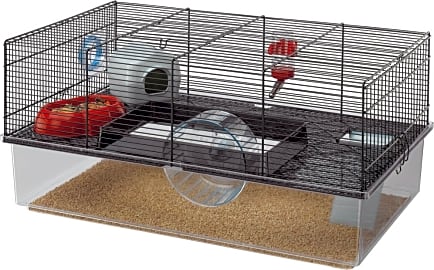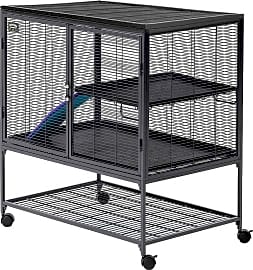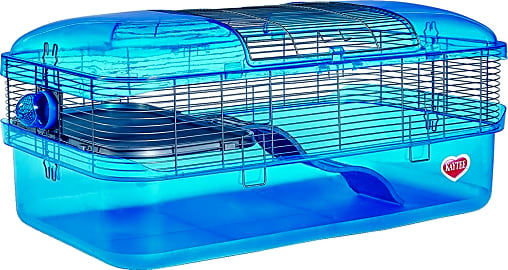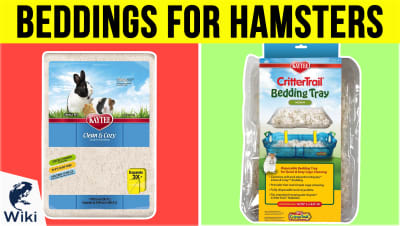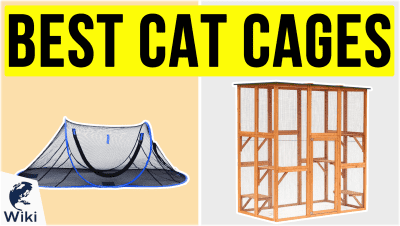The 6 Best Hamster Cages

This wiki has been updated 42 times since it was first published in July of 2015. There are few things in this world that are as cute as little hamsters. Of course, once you get one, you'll also need to buy an adequately sized cage for your tiny buddy, and our selections include some of the top models available today. These posh digs offer room for it to run around and exercise, places to hide, and plenty of accessories to keep it happy and entertained. When users buy our independently chosen editorial recommendations, we may earn commissions to help fund the Wiki.
Editor's Notes
June 25, 2021:
We're pleased to report that our selections are still among the best available. In particular, the Midwest Homes for Pets Critter Nation is an extremely nice unit, as long as you have the space for it. If you can't find a place for it, though, the Prevue Pet Products 528 is especially nice for a countertop model. The Kaytee My First Home Multi-Level is our favorite three-story version, and the Kaytee CritterTrail Super is a good budget choice. If the Kaytee isn't big enough on its own, it's also designed to mate with others from the same brand for expansion.
February 15, 2020:
The size requirements of a hamster cage are a matter of debate, with some owners and organizations recommending a minimum of 24 x 12 x 12 inches, and others suggesting a slightly larger 450 square inches. All items on this list meet the former requirement, and most meet the second, with the exception of the Ferplast Favola at 340 square inches. This model is most likely best for owners who are able to give their little critter plenty of cage-free play time. But keep in mind that most organizations now simply state that bigger is always better, so look for the largest cage you can comfortably afford.
Because we are concerned about the safety of the wire platform found on the Lixit Animal Care Savic Mickey, we've decided to remove it at this time. You'll find that wire surfaces can potentially injure a hamster's tiny feet; it's not a given, but it's not worth the risk for most. But we still like the Lixit Animal Care Savic Heaven Metro, although its multiple pieces make it a bit hard to clean. When it comes to simplicity, though, it's tough to top the Prevue Pet Products 528. It doesn't have a lot of bells and whistles, but that also means you won't struggle for hours to clean all the nooks and crannies, and that it will blend in with a room's décor, rather than stand out. It, along with the Kaytee My First Home Multi-Level, are deep enough to accommodate various types of beddings for hamsters. Finally, we have kept the large and convenient Midwest Homes for Pets Critter Nation, but with 1/2-inch bars, it's not appropriate for very small hamster varieties.
Special Honors
Exotic Nutrition 4-Level Mansion The Exotic Nutrition 4-Level Mansion is certainly that, standing a huge 44 inches tall alone and 58 inches tall once it's placed on the stand. You'll find wheels and a shelf on this bottom part, both nice touches, and the metal trays pull right out for cleaning. Its bar spacing is half an inch, so skip this one for smaller varieties, including dwarves. exoticnutrition.com
Home For A Hamster: Finding The Right Cage
In other words, don't think a cage is sufficient for multiple hamsters just because it is large; interior design, as it were, is important.
Hamsters are cute, curious, and loving little creatures, so it's not surprising that they are one of the most popular pets in the world. Keeping and caring for hamsters is relatively easy just so long as you do a bit of research and reading before you adopt or buy your first animals and establish the right habitat for them. With the right diet and water provided and an occasional cage cleaning, hamsters need only toys and the occasional affection to enjoy a safe and happy life.
When choosing the right hamster cage for your home, first think about the ideal cage size. Do this by considering how many hamsters you are likely to have roaming about within it. While naturally playful and usually friendly to fellow members of their species, a hamster nonetheless needs plenty of space to move about without feeling crowded or cornered. Too small a hamster cage filled with too many animals can lead to conflict including violent clashes. So if you want a small hamster cage, be sure to keep a small number of critters within it.
For many people, a hamster cage small enough to perch on a tabletop and with two rodents calling it home is the ideal arrangement -- just make sure said rodents are either "fixed" or are of the same gender, or the cage will soon be outgrown. If you choose to keep just one hamster, make sure to select appropriate toys and exercise devices in the cage (see below for more information there), as even a diminutive rodent can get bored in life.
If you want to get a larger hamster cage that can accommodate multiple animals, you're in for a treat: thanks to the natural curiosity and agility of the hamster, hamster cages come in all sorts of shapes and designs. You can select a cage that sports numerous tunnels and chambers in which hamsters can skitter about or snuggle up, or you can select a cage with multiple platforms and levels which will keep the animals playfully running up and down all day long. Just keep in mind that cages with many long tunnels can be more laborious to clean, as accessing the droppings, leftover food, and other detritus within these labyrinthine accommodations can at times require some disassembly of the habitat.
Make sure that any hamster cage not only corresponds to its number of "residents" in terms of its overall size, but that it also has enough "rooms" and nooks and crannies for each hamster to carve out some personal space when needed. In other words, don't think a cage is sufficient for multiple hamsters just because it is large; interior design, as it were, is important.
Also note the age of your hamsters, or plan ahead for a time when the playful little rodents won't be quite so spry. Older hamsters need a cage with easy to access food and water serving areas and should not have to do much climbing to get to comfortable burrows.
A Few Things Hamsters Need
It won't come as much of a revelation to hear that perhaps the single best accessory you can get for a hamster habitat is a hamster wheel. These devices, which connect a rodent powered wheel or disc to an axle with a low coefficient of friction, allow a caged animal to enjoy the freedom of running and exercise, letting them stay amused and make use of their extremely fast metabolisms at once.
Use bedding made from cellulose, aspen wood shavings, or sheets of paper not treated with dyes and free of ink.
Also consider a hamster ball for allowing your animals the occasional foray outside of the cage. Just be sure that all bipedal residents of your home are aware when a hamster is on the loose, and make sure not to let the rodent roll about anywhere near stairs or open exterior doors. However they get it, know that hamsters absolutely need exercise.
As hamster (and other small mammal) teeth grow constantly, the animals need to regularly gnaw on solid materials to keep their teeth trimmed and healthy. In the wild, this would be done using everything from nuts to roots to pine cones. In captivity, they just be provided with a material on which to gnaw. Make sure your hamster cage always has a supply of safe chewing options, such as sticks made of applewood or cherrywood. It's best to buy rodent chews from a store to ensure they are safe; many woods you will find around the home may have been treated with chemicals, and the sticks you find outside might have parasites or else may have begun to rot.
Finally, give your hamsters a way to do some good burrowing. This can be as simple as leaving some paper towel tubes in the cage into which they can crawl and hide out, or it can mean providing bedding into which they can dig. Use bedding made from cellulose, aspen wood shavings, or sheets of paper not treated with dyes and free of ink.
The Hamster: One Popular Rodent
Hamsters belong to the Cricetinae family of the Rodentia order, and are divided into more than two dozen species within their family. The most notable features of most types of hamster include their almost spherical appearance, their ability to store huge amounts of food in their large cheek pouches, and their extreme cuteness.
Hamsters belong to the Cricetinae family of the Rodentia order, and are divided into more than two dozen species within their family.
For being so charming in looks and behavior, and thanks to the relative ease of their care, hamsters are not only one of the most overall common pets in America, but indeed are the most popular small rodent kept as a pet. (They are more common than domestic gerbils, for example.)
If you already own or are considering getting a hamster, it's a good idea to have a bit of base knowledge about their diet and lifespan so you can aid with one and anticipate the other. Wild hamsters eat mostly seeds, nuts, occasional fruits, and sometimes insects. Domestic hamsters can be kept healthy using store bought feeds, but also benefit from occasional treats of fresh vegetables, fruits, nuts, and seeds.
The average lifespan of a wild hamster is usually two years or less across most hamster species. Captivity tends to add a year (or even two years on occasion) to their lives.



